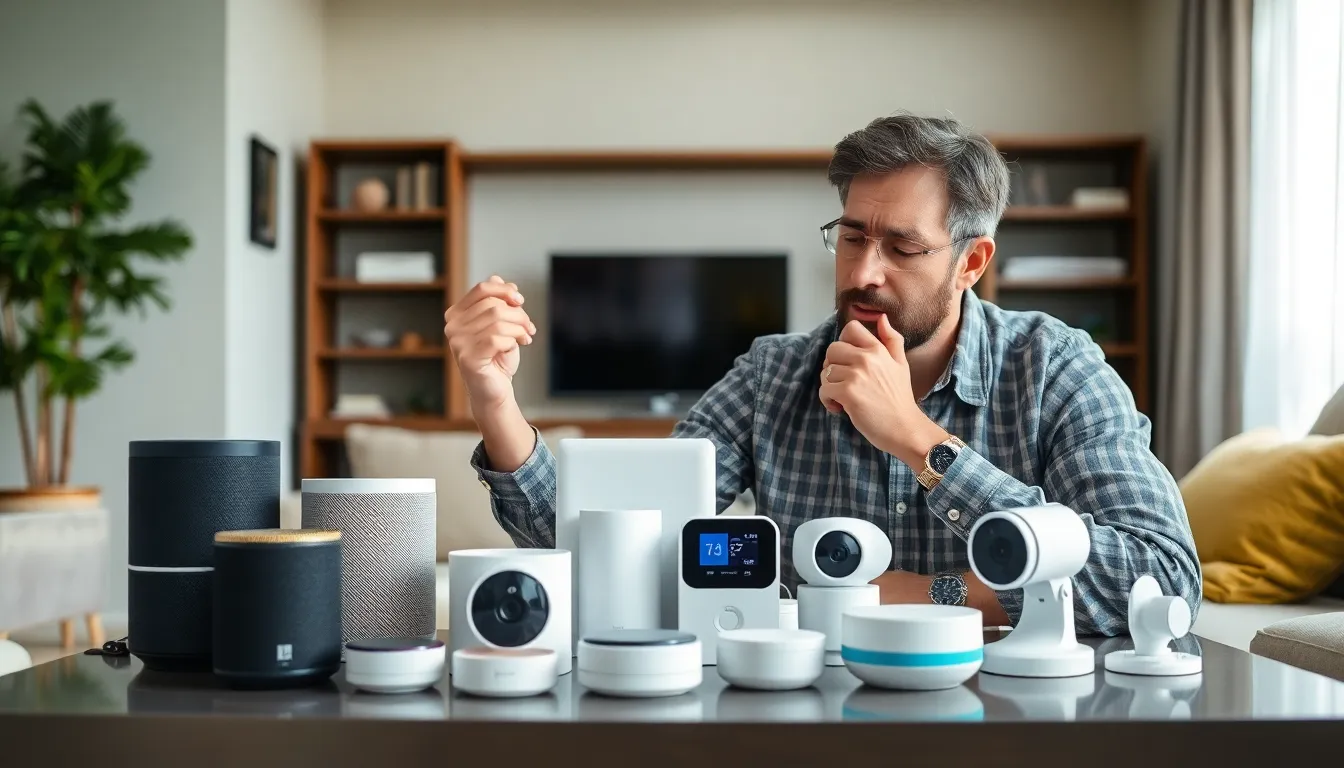Table of Contents
ToggleImagine walking into your home and having the lights dim just right while your favorite playlist starts to play. Sounds like a scene from a sci-fi movie, right? Well, welcome to the world of smart homes, where technology meets convenience. But before diving headfirst into this gadget wonderland, there’s one crucial question that looms large: what’s the cost of turning your humble abode into a tech-savvy haven?
Overview of Smart Home Technology
Smart home technology encompasses a range of devices and systems designed to enhance convenience, security, and energy efficiency within a living space. Homeowners utilize smart devices to gain control over various functions, such as lighting, heating, climate control, and security systems.
Smart speakers and virtual assistants serve as central hubs for managing many devices, simplifying interactions through voice commands. Automated lighting systems adjust brightness based on time of day or occupancy, creating comfortable environments while conserving energy.
Security products, including smart locks and cameras, provide real-time monitoring and alerts. These systems connected to smartphones allow instant access to critical information, increasing homeowners’ peace of mind. Smart thermostats optimize heating by learning user preferences, resulting in significant energy savings.
Integration between devices enhances the smart home experience. Homeowners can create scenarios where multiple devices work together, such as setting the lighting to dim and music to play when the home theater is activated. Such interconnectivity fosters a seamless environment that adapts to users’ lifestyles.
Investing in smart home technology improves quality of life and adds value to residential properties. The growing market for smart devices indicates a shift toward more advanced living spaces, with extensive options available for consumers. Understanding both the features and costs associated with these technologies helps individuals make informed choices, ensuring financial alignment with their goals.
Market research reveals that smart home technology will grow significantly, driven by continual advancements and consumer demand. This transformation in home automation reflects broader trends in technology and energy use, underscoring the value of modernizing living spaces.
Factors Influencing Smart Home Installation Cost

Several factors impact the cost of smart home installation. Understanding these elements helps homeowners make informed decisions regarding their investments.
Equipment and Device Costs
Smart home devices include smart speakers, cameras, thermostats, lights, and locks. Prices for these items vary significantly based on brand, features, and compatibility. A basic smart device may range from $30 to $100, while advanced equipment can exceed $500. Bundling multiple devices often leads to discounts. Quality devices not only improve performance but also ensure compatibility with existing home systems.
Installation Labor Costs
Labor costs vary based on location and complexity of the installation. Professional installers typically charge between $50 and $150 per hour. Basic setups, such as connecting smart lights, require less time and cost less, while intricate installations involving multiple systems incur higher labor expenses. Homeowners may opt for DIY installations, which can reduce costs but may lead to challenges with configuration and compatibility.
Home Size and Layout
Home size and layout significantly influence installation expenses. Larger homes often require additional devices and longer installation time. Complex layouts may necessitate increased wiring and coordination between systems. Installing smart technology in smaller spaces typically demands fewer devices and less labor, resulting in lower overall costs. Homeowners should assess their specific requirements to determine an accurate budget for smart home implementation.
Comparison of DIY vs. Professional Installation
Homeowners often face a choice between DIY installation and hiring professionals for smart home setups. Each option presents unique advantages and challenges.
Pros and Cons of DIY Installation
DIY installation offers flexibility and potential cost savings. Individuals can choose devices based on personal preferences without labor fees. Skills in basic wiring or networking contribute to a smoother process. However, tackling complex setups may lead to mistakes, resulting in device malfunctions. Time investment can be significant, particularly for beginners. Additionally, some systems may void warranties if not installed by a professional.
Pros and Cons of Professional Installation
Professional installation guarantees expertise and efficiency. Installers bring experience with various smart home devices, ensuring optimal functionality. Warranties often remain intact when professionals handle setups. Yet, costs can add up, with hourly rates ranging from $50 to $150. Scheduling conflicts may arise, causing delays in implementation. Homeowners must weigh these factors against the value of convenience and peace of mind offered by professional services.
Cost Breakdown by Smart Home Components
Understanding costs associated with smart home components helps homeowners create effective budgets. Below is a breakdown of key systems.
Security Systems
Security systems are crucial for home safety. Basic packages with cameras and alarms range from $150 to $400. Advanced options, like smart locks, can exceed $500. Monthly monitoring fees may add $20 to $60 to overall costs. Professional installation services generally charge between $100 and $200. While DIY setups may save money, errors can lead to costly repairs.
Lighting Control Systems
Lighting control systems enhance convenience and energy efficiency. Systems can begin at $50 for simple smart bulbs and exceed $200 for complete setups with dimmers and switches. Integration with existing wiring may add installation costs ranging from $75 to $150 per hour. Energy savings from smart lighting can significantly offset initial investments over time. Upgrading to smart lighting can also increase home appeal and resale value.
Heating and Cooling Solutions
Smart heating and cooling solutions optimize comfort and efficiency. Smart thermostats start around $100 and can go up to $250 for more advanced models with learning capabilities. Installation typically varies between $75 and $150. Integrating HVAC systems with smart technology ensures energy savings. Properly managed systems reduce utility costs, making them a valuable long-term investment.
Budgeting for Smart Home Installation
Assessing costs for smart home installation requires careful consideration of multiple factors. Equipment and device costs can range significantly; basic smart bulbs may cost $30, while advanced security systems might exceed $500. Installation expenses also vary, with professionals charging between $50 and $150 per hour based on location and complexity.
Home size significantly influences budget estimations. Larger properties need more devices and longer installation times, translating into higher costs. Evaluating the layout can help homeowners understand how many devices are necessary, thus improving budgeting accuracy.
DIY installations offer an alternative by eliminating labor costs. While this path may seem attractive due to potential savings, mistakes can happen, especially for those without experience. Homeowners should weigh the time investment against the potential risks of DIY errors.
Professional installation guarantees expertise and ensures devices operate optimally. Warranty coverage remains intact when installing equipment through professionals, giving homeowners peace of mind. Contracting professionals may come with scheduling challenges, so planning ahead becomes essential.
Security systems serve as a critical component of smart home setups. Basic packages start around $150 but can rise to over $400 for advanced configurations, not including ongoing monitoring fees. Lighting control systems begin at $50 for simple devices, with entire setups exceeding $200 depending on features and brand.
Lastly, smart heating and cooling solutions play a vital role in energy management. Thermostats typically start around $100, but installation costs can vary based on specific needs. Homeowners should explore these expenses to create a comprehensive budget that aligns with their smart home objectives.
Smart home technology offers incredible benefits but comes with a range of costs that homeowners must carefully consider. By understanding the financial implications of equipment, installation, and the choice between DIY or professional help, they can make informed decisions that suit their needs and budgets.
Taking the time to assess personal requirements and potential savings can lead to a more efficient and enjoyable living environment. As smart home technology continues to evolve, staying informed about pricing trends and product options will empower homeowners to enhance their spaces while maximizing value.






